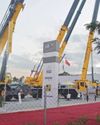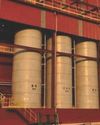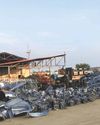
An estimated 30% of today's world steel production is through the electric arc furnace (EAF) steel-making route. This contribution to world steel production is likely to continue, given that EAF steel-making is more environment friendly and there is availability of a huge stock of scrap steel on earth, waiting to be recycled. It is, therefore, important that EAF steel making improves in terms of efficiency and productivity.
As a chemical reactor in steel making, EAF is quite slow compared to the basic oxygen furnace (BOF) route. The conditions that drive chemical reactions between slag and metal are impaired by insufficient intermixing of slag and metal during the process. That's not all. There is an additional limitation. The design of an EAF is such that there is always a possibility of slag flowing out through the slag-door early in the process. Early flowing out of slag is a huge problem and is seen in EAF operations where awareness about the resultant losses is poor. It could also be because the operators are not trained well enough to take countermeasures. In some organisations, there is no system of monitoring, analysing and reducing these losses. While slag is basically a solution of metallic oxides required for refining of steel, it is also a sink for iron – in the form of iron oxide (FeO) – the valuable metal that we strive to recover. Loss of unreduced slag is a direct loss of iron (Fe). In addition, early loss of slag adversely affects arc stability, refractory life, heat insulation of bath, power consumption, electrode consumption, etc. The importance of slag in the EAF process makes it imperative that the approach to EAF steel making should focus on the following:
Holding slag inside EAF;
Extracting iron and all other benefits from it; and
Finally, releasing it through the slag door.
この記事は Steel 360 の November 2019 版に掲載されています。
7 日間の Magzter GOLD 無料トライアルを開始して、何千もの厳選されたプレミアム ストーリー、9,000 以上の雑誌や新聞にアクセスしてください。
すでに購読者です ? サインイン
この記事は Steel 360 の November 2019 版に掲載されています。
7 日間の Magzter GOLD 無料トライアルを開始して、何千もの厳選されたプレミアム ストーリー、9,000 以上の雑誌や新聞にアクセスしてください。
すでに購読者です? サインイン

Sajjan Jindal's Pills For Steel Sector Ills
Making an impassioned cry for the entire steel industry to come forward and join hands to devise ways to increase steel consumption in India, Sajjan Jindal, Chairman of the JSW Group, recently said the USD 200-250 billion of investment that will be required to produce the 300 million tonnes (MnT) of steel by 2030 should be made in all “Make in India” equipment.

Galvanised Rails On Track To Be INR 1,400-CR Opportunity
If all goes well, Indian Railways (IR) could be having an INR 1,400-crore, 2 lakh tonnes per annum order for galvanised rails to offer one-and-half years down the line. And two leading producers of rail tracks in India, the Steel Authority of India (SAIL) and Jindal Steel & Power (JSPL), could be in the fray to bag the orders, it is learnt.

Crysteel Gazing
What lies in store for India's steel industry in 2020?

Are Indian Steel Makers Ready To Combat Arcelormittal's Arsenal?
Armed with deep pockets and the best available technology in its arsenal, the world’s largest steel maker, ArcelorMittal, is all geared up to own and steer an operating 10-million tonnes per annum (MnTPA) steel plant in India, and a growing market that offers an attractive opportunity for steel firms with excess capacity from China, Japan and Korea (more so for the last two, owing to favorable trade agreements) to dump products unbridled at predatory prices

Construction Equipment Sector May See 40% Growth In Sales
The construction equipment industry can expect a 40% increase in sales in the near future on the back of huge government spending on infrastructure projects.

Acid Test
When it comes to spent pickle liquor, steel makers need to embrace innovative solutions to reduce environmental impact & increase efficiency

Stress On 'Scientific Mining': Odisha Mining Lease Area Cap Eased
But govt's decision keeps industry divided

Let's Get Carbon-Smart
Innovations are inevitable for the global steel industry to ride over the myriad challenges that the worldwide environmental crisis has thrown up. And almost all the ground-breaking innovations in steel technology have been geared towards confronting and mitigating the carbon challenge. The singular objective of disruptive technologies is to become, what has been aptly termed as “carbon smart”, by not just replacing fossil sources with natural gases for metals production but also recycling fossils and wastes to produce useful products at an industrial scale, thereby providing a huge fillip to the global circular economy. Steel360 turns the spotlight on three “green” technologies that are setting new benchmarks in the industry.

Loss Of Unreduced Slag Is A Direct Loss Of Iron
Improving EAF operations through monitoring and control of slag residence time

Auto Scrap Facility Draft Norms Drive Home ‘Green' Point
However, ambiguities keep stakeholders at crossroads